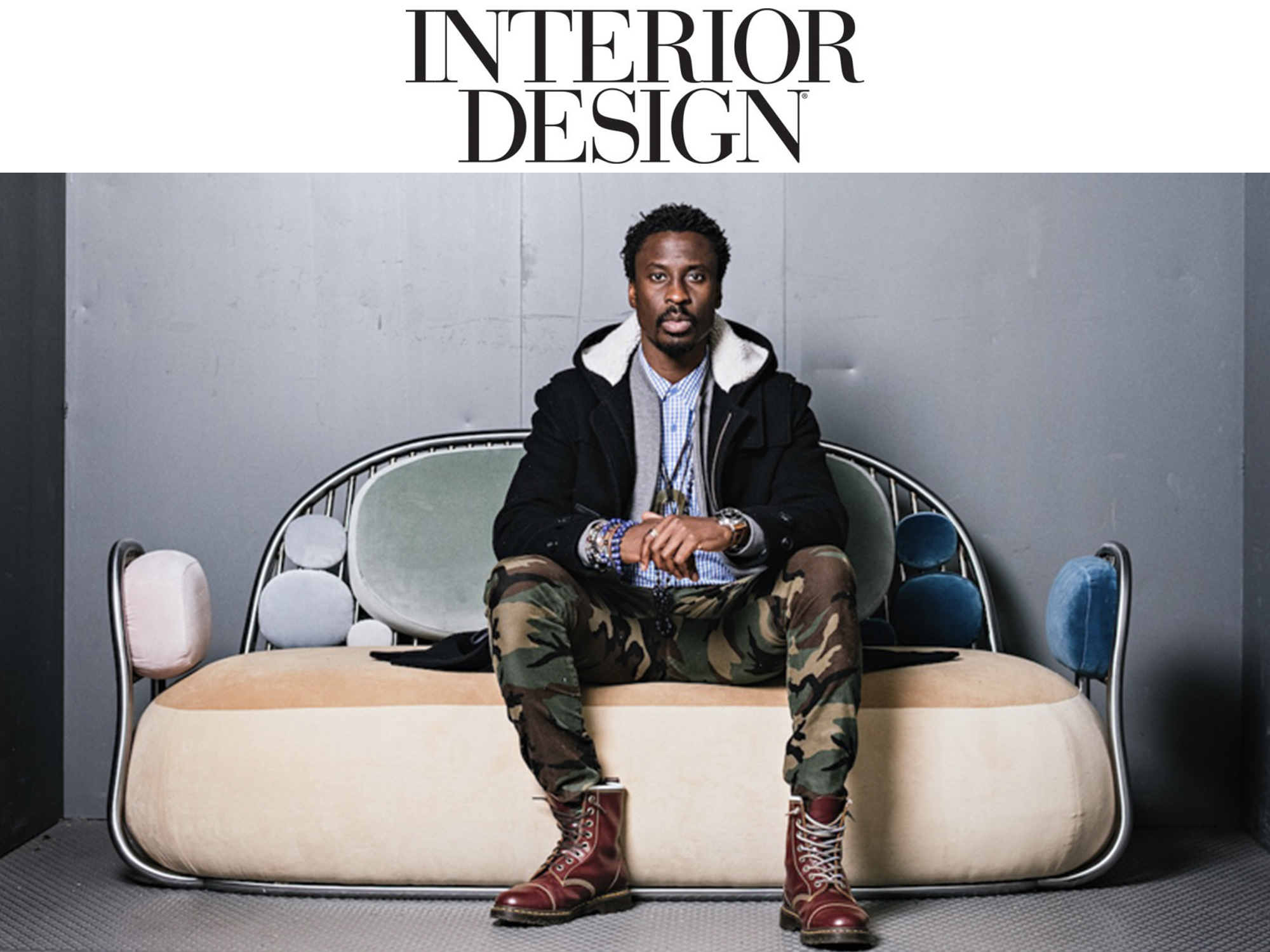By Mairi Beautyman
“Storytelling objects” is how Ini Archibong describes his highly original furnishings, crediting his vision to a perspective gleaned from education, sensitivity to material and craft, and life experience. For the past two years, the designer’s 22-piece Below the Heavens collection, launched in two parts for Sé, made waves at Milan Design Week. Furnishing rooms at Galleria Rossana Orlandi, his rich exploration of soft lines and curves emerged in strikingly new forms
The son of Nigerian immigrants to the United States, Archibong was born and raised in Pasadena, California. After stints around the globe, he now lives in Switzerland, where he heads up Design by Ini out of a renovated factory. Recently he sat down with Interior Design to share more on cues taken from heaven and earth, what has traveled with him with on every international move, and the popular 3D combination puzzle he keeps in just about every room in his home.
Interior Design: What was the overall design goal of Below the Heavens?
Ini Archibong: Below the Heavens first launched in 2018 and continued in 2019. The name references my inspiration: the eternal interplay between heaven and earth. If Part I was celestial and sky-gazing, then Part II is more terrestrial and monumental. Part I was more dreamy. We had a lot of things hanging from the ceiling or going on over your head. In terms of color and materials, I think there were lighter and softer hues. For Part II, I was particularly inspired by the monolithic shapes of standing stones or rock formations. These new pieces are statuesque and mature, achieving a harmonious balance alongside the exuberance of Part I. If you look at the desk, dining chairs, or executive chair, all of these things are monolithic. You could put them next to pictures of Stonehenge, the statues on Easter Island, or the rock columns at the Giant’s Causeway, and they would be a lot more relatable than the pieces in Part I. Part II also uses more earth tones.
ID: What else have you completed recently?
IA: With the idea to create something that would be perceived as futuristic, yet simultaneously classical, I just designed a watch, the Galop d’Hermès, for Hermès. It has basically the same materials of any high-end watch—steel, gold, diamonds, alligator leather—but I let the heritage of the Hermès brand dictate the form, rather than convention. Most watches you see are round or square so the form of this is different. I also participated in “Speechless: Different by Design,” an immersive exhibition that opened in November at the Dallas Museum of Art.
ID: What’s upcoming for you?
IA: I am represented by New York gallery Friedman Benda, so I have collectable design or sculptural objects in the works that will be shown at different art fairs around the world. I’m also working on a collection for furniture manufacturer Knoll.
ID: In what kind of home do you live?
IA: My home and studio are one and the same, and I live in a former minted metal factory—now renovated into apartments—in Neuchatel, Switzerland. The factory made trophies, coins, and even Olympic medals, and there are really high ceilings and a wall of windows facing Lake Neuchâtel. It is important to me to have a lot of natural light in my workspace.
ID: What of your furnishings has particular value to you?
IA: My turntable and my Akai MPC1000 drum machine have been with me for 10 years, moving from San Francisco to New York, Singapore, and Switzerland. I also keep concert posters, and have a framed vinyl of Kendrick Lamar’s “Good Kid, M.A.A.D City,” which reminds me of home and growing up in LA.
ID: How did your childhood influence your design thinking?
IA: I started learning 3D modeling at the age of 12. Having parents that provided me with the software and tools to explore my (then) strange fascination, allowed me to have a strong spatial understanding and a fluency within CAD and 3D software that most of my peers didn’t achieve until university. Back then a lot of 3D modeling was used to make landscapes for video games, and I just got into creating universes and animations—usually with spaceships and star fighters or other things I saw in comic books. I was also really into tagging, so I would take these little tags from my sketchbook, realize them in Adobe Photoshop, and then take them into 3D software and do things with them.
ID: Could you name a person in the industry you particularly admire?
IA: The American architect, engineer, and futurist R. Buckminster Fuller because of the Trimtab concept, based on using opposition to accomplish a goal.
ID: Do you have an instagram hashtag you follow?
IA: #geology
ID: What are you reading and why?
IA: “The Inner Reaches of Outer Space: Metaphor as Myth and as Religion” by Joseph Campbell —for expansion of awareness. When you consume the truth, things make more sense and you are more conscious of what is going around you. This helps you see how certain archetypes and typologies have been used in the past and therefore do things with more intention.
ID: Do you have a secret you can share?
IA: In my home, there’s at least one Rubik’s Cube in every room. If I see an interesting colorway or design I’ll get it—I have traditional, but also grayscale, army camouflage, and white. A Rubik’s cube is something I constantly do when I am thinking. They keep my hands engaged and my brain sharp.










